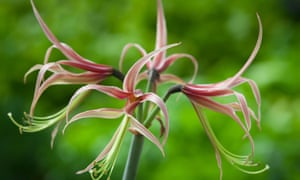
‘Ihave ordered some amaryllis bulbs,” I say. This doesn’t go down so well at home. Hippeastrum (often wrongly known as amaryllis) are seen as highly naff. Big, gaudy blooms, often the wrong shade of red or pink or both, perhaps with some white picotee edging for effect. “I have ordered very tasteful varieties in green and deep red,” I say. This is met with very little approval. Still, they’re in the post and I will eat this newspaper page by page if they don’t appeal.
Many hippeastrum varieties still uphold the gaudy tradition. Mostly these come in gift boxes that say “Christmas amaryllis”; avoid them. They can be expensive and the bulbs on the small size. With hippeastrum, size is everything: bigger bulbs will have larger, more numerous flowers.
I like the elegant, otherworldly blooms of the Spider group best. They all have the small spidery blooms of H. cybister in their lineage. The most readily available include salmon-red ‘Sumatra’ and ‘Evergreen’, which has three or four pale green flowers per stem. These are matched in their weirdness only by H. cybister‘Chico’. The top half of its narrow petals are a deep red and the bottom half the palest green. It looks like a very strange deep-sea creature, yet it’s just an easy-to-please houseplant.
At the right temperature, flowering will take roughly six weeks. You can plant bulbs all the way up to January, so they make nice Christmas gifts. If the recipient is not a gardener, I would pot them up first and give strict watering instructions.
Once open, the flowers last for a month or more and with the right aftercare the bulbs will bloom for years to come. They start at a fiver (these tend to be rather poor) and go up to £13, so it’s well worth investing a little in them so they do their thing next year.
H. cybister is native from Bolivia to Argentina, which means the bulbs are not frost-hardy, though they can spend the summer outside while dormant, as long as they don’t get rained on.
You will need peat-free compost, either multipurpose or houseplant. The pot should be only marginally larger than the bulb itself and two-thirds of the bulb should remain above the surface of the compost; plant too deep and it will rot off.
Place it somewhere sunny and at least 21C. Cooler temperatures will mean the flower spikes will take eight to 12 weeks to appear. Water the bulb in and then sparingly until the new leaves appear, at which point you need to start watering regularly. Don’t let the compost become bone-dry, but the pot should never sit in water either. The best way to work this out is to pick up the pot when it has been just watered and gauge the weight; when the pot feels light, it’s time to water again.
You need to turn the pot regularly to make sure the flower spike grows straight. Once the flower opens, move the plant to a cooler location (about 15-18C) to make the blooms last.
[Source:- The Gurdian]
